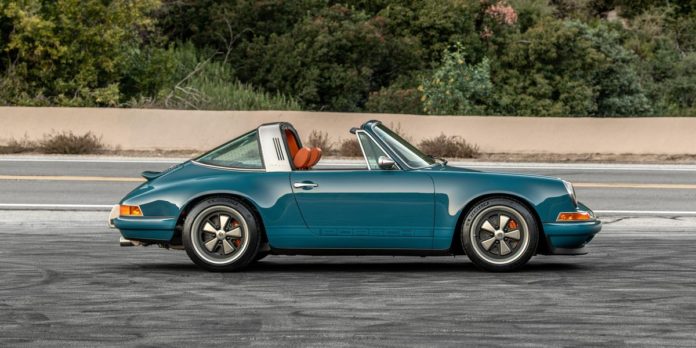- Singer, the boutique Porsche specialist restoration shop, has just released its 300th “Classic Study” 964 911.
- The car is a 1990 Targa done up in Resistance Blue with orange interior.
- Singer employs 600 workers in the U.S. and the U.K.
Boutique restoration shop Singer just finished its 300th “reimagining” of a Type 964 Porsche, and the world is a better place for it.
The little company, started by former rock ‘n’ roll vocalist (hence the company name) Rob Dickinson, now has 600 employees and operations in the U.S. and the U.K. Since its humble beginnings, it has grown in almost every way, now including boutique restorations on turbos as well as naturally aspirated air-cooled 964 911s.
“I fell in love with the Porsche 911 as a kid in the 1970s,” Dickinson, founder and executive chairman of Singer Group, told Autoweek. “Later I founded Singer with the aim of celebrating the heritage of this remarkable car. It’s won at Le Mans, taken children to school, and driven Pacific Coast Highway with the roof down.”
The lucky 300th Porsche 911 reimagined by Singer–Classic Study is a 1990 911 Targa with carbon-fiber bodywork in Resistance Blue with ghosted stripes, Singer says. The car was named Sotto by its unspecified owner and commissioner.
(“Please ensure the car is referred to using the correct name,” Singer says on the car’s spec sheet, “Sotto Commission.” Singer is also painfully specific about making sure you don’t say “Porsche” in the wrong context, or “911” or even “Targa,” going so far as to insist we sign a document agreeing to let them see any article we write before publication. We refused to sign, and because of that we didn’t get to drive this car.)
“Through the Classic Study we help owners to pursue their personal vision for the ultimate air-cooled 911, inspired by all these elements of the 911’s backstory,” Dickinson told us. “The fact that we’ve now restored 300 cars for clients around the world is testament to the love that so many people have for the world’s most important sports car.”
The engine in the 300th is a 4.0-liter naturally aspirated, air-cooled flat six-mated to a five-speed manual transmission. Singer says it makes 390 horsepower. The Turbos can make 700 horses.
The interior is trimmed in orange leather with contrasting black stitching. The brightness would be distracting in any other car.
Autoweek first drove a Singer way back in 2018 and at that time said, “Yes, it is as good as the hype.”
“Is it worth over half a million bucks?” we asked rhetorically. “Well, what is? If you want value for the dollar, buy a Camry. These things are rolling works of art, the details of which have been painfully perfected over the years under the watchful eye of founder Dickinson.”
Back then, when the firm had only made 100 cars, we noted the zeal of Dickinson for his creations:
One night that now lives in infamy, Dickinson walked through the shop and saw something he wanted tended to on one of the cars. So he put a little Post-It note on the car where he wanted the change. Then he saw something else. And something else. By the time the crew came back the next morning, the place was wallpapered with Post-It notes.
“Come on, Rob, these things can’t all be that important, can they?” To which Dickinson famously screamed, “EVERYTHING IS IMPORTANT!” To drive it home, he grabbed a can of spray paint and graffitied the wall of the shop with those words. They (the words, not the workers) now hang from the ceiling of the shop in artistic 3D in the original cursive, lowercase script of the graffito, “everything is important.” Indeed, the emoji of Dickinson’s screaming mug is emblazoned on the speedometer of some of his creations.
While we have heard there are now something like 30 different shops doing something very similar to what Singer is doing, none are doing it quite like this.
So congratulations on your 300th screaming head steering wheel center cap, Rob. Looking forward to numbers 400 and 500.

Mark Vaughn grew up in a Ford family and spent many hours holding a trouble light over a straight-six miraculously fed by a single-barrel carburetor while his father cursed Ford, all its products and everyone who ever worked there. This was his introduction to objective automotive criticism. He started writing for City News Service in Los Angeles, then moved to Europe and became editor of a car magazine called, creatively, Auto. He decided Auto should cover Formula 1, sports prototypes and touring cars—no one stopped him! From there he interviewed with Autoweek at the 1989 Frankfurt motor show and has been with us ever since.



